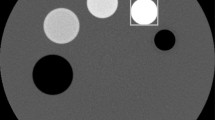Abstract
Computed tomography (CT) measures the attenuation coefficient of an object and converts the value assigned to each voxel into a CT number. In radiation therapy, the CT number, which is directly proportional to the linear attenuation coefficient, must be converted to an electron density for radiation dose calculations for cancer treatment. However, if various tube voltages are applied to take the patient’s CT image without applying the specific CT number to the electron density conversion curve, the accuracy of the dose calculation is not assured. In this study, changes in CT numbers for different materials due to changes in the tube voltage were demonstrated, and the dose calculation errors in the percentage depth dose (PDD), along with a clinical case were analyzed. The maximum dose difference in the PDD from the treatment planning system (TPS) dose calculation and from the Monte Carlo simulation were 1.3% and 1.1%, respectively, when applying the same CT number to the electron density conversion curve for the 80-kVp and 140-kVp images. In the clinical case, different CT number to electron density conversion curves at tube voltage of 80 kVp and 140 kVp were applied to the same image and the maximum differences in the mean, maximum, and minimum doses were 1.1%, 1.2%, and 1.0%, respectively, at the central region of the phantom and 0.6%, 0.9%, and 0.8%, respectively, at the peripheral region of the phantom.
Similar content being viewed by others
References
J. S. Fleming, Nucl. Med. Commun. 10, 83 (1989).
C. Burger, G. Goerres, S. Schoenes, A. Buck, A. H. Lonn and G. K. Von Schulthess, Eur. J. Nucl. Med. Mol. I. 29, 922 (2002).
C. T. Chantler, Q. Tran, Z. Barnea, D. Paterson, D. J. Cookson and D. X. Balaic, Phys. Rev. A 64, 062506 (2001).
R. J. Cropp, P. Seslija, D. Tso and Y, Thakur, J. Appl. Clin. Med. Phys. 14, 338 (2013).
C. B. Saw, A. Loper, K. Komanduri, T. Combine, S. Hug and C. Scicutella, Med. Dosim. 30, 145 (2005).
K. H. Cho et al., Korean. J. Med. Phys. 4, 161 (2005).
S. Kang, B. Cho, H. Park and H. Bae, Korean. J. Med. Phys. 15, 23 (2004).
S. Agostinelli et al., Nucl. Instrum. Meth. A 506, 250 (2003).
J. Allison et al., IEEE. T. Nucl. Sci. 53, 270 (2006).
S. K. Kang, M. W. Lee, Y. R. Kang, J. D. Hyeok, J. Y. Kim, K. K. Lee and M. S. Rock, New Phys.: Sae Mulli 62, 1357 (2012).
F. C. du Plessis, C. A. Willemse, M. G. Lötter and L. Goedhals, Med. Phys. 28, 582 (2001).
Author information
Authors and Affiliations
Corresponding author
Rights and permissions
About this article
Cite this article
Rhee, D.J., Kim, Sw., Jeong, D.H. et al. Effects of the difference in tube voltage of the CT scanner on dose calculation. Journal of the Korean Physical Society 67, 123–128 (2015). https://doi.org/10.3938/jkps.67.123
Received:
Accepted:
Published:
Issue Date:
DOI: https://doi.org/10.3938/jkps.67.123




